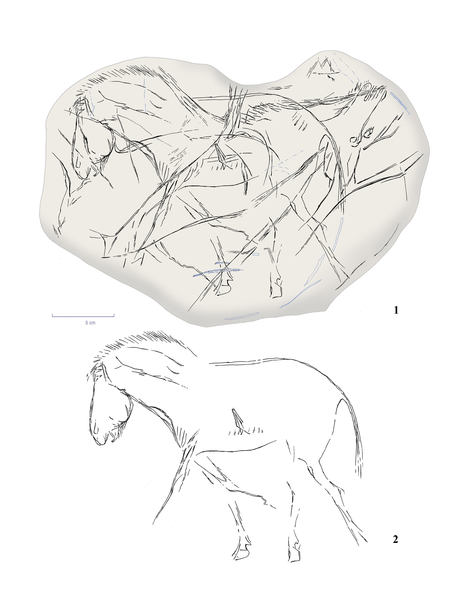- Home
- The engraved pebble from Étiolles
- A major discovery
- Exceptional artistic evidence
- The back
The engravings on the back are much denser than on the front and deciphering them is more difficult. There is another horse, walking towards the left, and if we turn the pebble 180° we can make out two reindeer, superposed, looking to the left, their heads intertwined.
The horse
The engraving is less firmly made than on the front and the lines are much finer, making it difficult to make out. The animal is short and stocky. Its tail is clearly separated from its thigh. At the top of the short neck is a broad head, with the ear turned down. The mouth is open. The nostril is indicated, but there is no eye. The four limbs are not attached to the body and only two have hooves. The front right limb appears to have a cloven hoof, but this is more likely to be another version of the engraving, slightly further forward. There is a wound on the centre of the thorax.
Copy of the back (with the horse the correct way round).
© doc. C. Fritz – G. Tosello
Copy of the horse on the back.
© doc. C. Fritz – G. Tosello
The reindeer
The left profiles of two cervids are superposed. First, we see a head, projected forwards and topped by sketchily indicated antlers. Then we see a fetlock and a brush of hair on the stomach. On the head, in unclear lines, there are two eyes and a double nose, as if a second cervid is hiding, a hypothesis that confirms the drawing of another body at an angle of 30 degrees to the previous one. The head is thrown back in a dynamic posture. The sketchy antlers, the same for both heads, have a large tine which suggests a webbed extremity, a detail which identifies the animals as reindeer.
1: The back (with the reindeer the correct way round).
2: The two reindeer.
3 and 4: Suggested reading of each reindeer (the same antlers)
© doc. C. Fritz – G. Tosello



